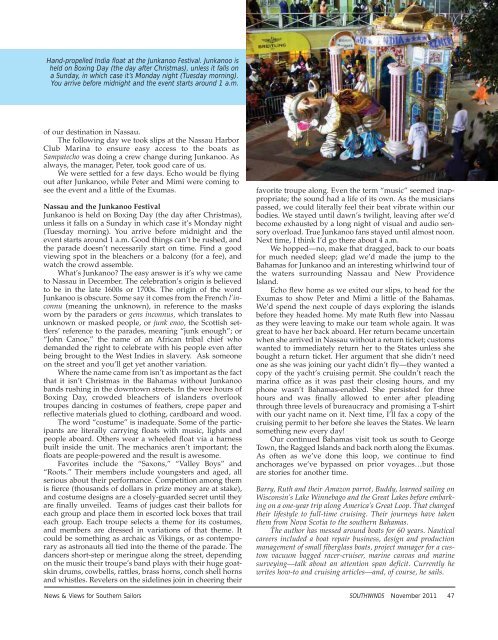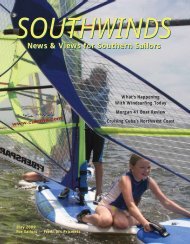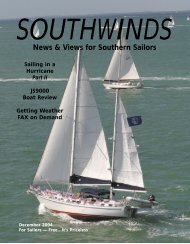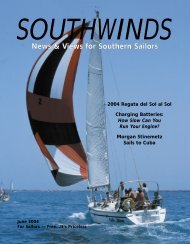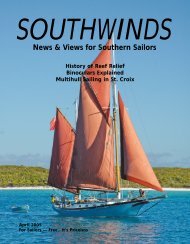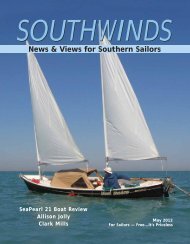News & Views for Southern Sailors - Southwinds Magazine
News & Views for Southern Sailors - Southwinds Magazine
News & Views for Southern Sailors - Southwinds Magazine
You also want an ePaper? Increase the reach of your titles
YUMPU automatically turns print PDFs into web optimized ePapers that Google loves.
Hand-propelled India float at the Junkanoo Festival. Junkanoo is<br />
held on Boxing Day (the day after Christmas), unless it falls on<br />
a Sunday, in which case it’s Monday night (Tuesday morning).<br />
You arrive be<strong>for</strong>e midnight and the event starts around 1 a.m.<br />
of our destination in Nassau.<br />
The following day we took slips at the Nassau Harbor<br />
Club Marina to ensure easy access to the boats as<br />
Sampatecho was doing a crew change during Junkanoo. As<br />
always, the manager, Peter, took good care of us.<br />
We were settled <strong>for</strong> a few days. Echo would be flying<br />
out after Junkanoo, while Peter and Mimi were coming to<br />
see the event and a little of the Exumas.<br />
Nassau and the Junkanoo Festival<br />
Junkanoo is held on Boxing Day (the day after Christmas),<br />
unless it falls on a Sunday in which case it’s Monday night<br />
(Tuesday morning). You arrive be<strong>for</strong>e midnight and the<br />
event starts around 1 a.m. Good things can’t be rushed, and<br />
the parade doesn’t necessarily start on time. Find a good<br />
viewing spot in the bleachers or a balcony (<strong>for</strong> a fee), and<br />
watch the crowd assemble.<br />
What’s Junkanoo The easy answer is it’s why we came<br />
to Nassau in December. The celebration’s origin is believed<br />
to be in the late 1600s or 1700s. The origin of the word<br />
Junkanoo is obscure. Some say it comes from the French l’inconnu<br />
(meaning the unknown), in reference to the masks<br />
worn by the paraders or gens inconnus, which translates to<br />
unknown or masked people, or junk enoo, the Scottish settlers’<br />
reference to the parades, meaning “junk enough”; or<br />
“John Canoe,” the name of an African tribal chief who<br />
demanded the right to celebrate with his people even after<br />
being brought to the West Indies in slavery. Ask someone<br />
on the street and you’ll get yet another variation.<br />
Where the name came from isn’t as important as the fact<br />
that it isn’t Christmas in the Bahamas without Junkanoo<br />
bands rushing in the downtown streets. In the wee hours of<br />
Boxing Day, crowded bleachers of islanders overlook<br />
troupes dancing in costumes of feathers, crepe paper and<br />
reflective materials glued to clothing, cardboard and wood.<br />
The word “costume” is inadequate. Some of the participants<br />
are literally carrying floats with music, lights and<br />
people aboard. Others wear a wheeled float via a harness<br />
built inside the unit. The mechanics aren’t important; the<br />
floats are people-powered and the result is awesome.<br />
Favorites include the “Saxons,” “Valley Boys” and<br />
“Roots.” Their members include youngsters and aged, all<br />
serious about their per<strong>for</strong>mance. Competition among them<br />
is fierce (thousands of dollars in prize money are at stake),<br />
and costume designs are a closely-guarded secret until they<br />
are finally unveiled. Teams of judges cast their ballots <strong>for</strong><br />
each group and place them in escorted lock boxes that trail<br />
each group. Each troupe selects a theme <strong>for</strong> its costumes,<br />
and members are dressed in variations of that theme. It<br />
could be something as archaic as Vikings, or as contemporary<br />
as astronauts all tied into the theme of the parade. The<br />
dancers short-step or meringue along the street, depending<br />
on the music their troupe’s band plays with their huge goatskin<br />
drums, cowbells, rattles, brass horns, conch shell horns<br />
and whistles. Revelers on the sidelines join in cheering their<br />
favorite troupe along. Even the term “music” seemed inappropriate;<br />
the sound had a life of its own. As the musicians<br />
passed, we could literally feel their beat vibrate within our<br />
bodies. We stayed until dawn’s twilight, leaving after we’d<br />
become exhausted by a long night of visual and audio sensory<br />
overload. True Junkanoo fans stayed until almost noon.<br />
Next time, I think I’d go there about 4 a.m.<br />
We hopped—no, make that dragged, back to our boats<br />
<strong>for</strong> much needed sleep; glad we’d made the jump to the<br />
Bahamas <strong>for</strong> Junkanoo and an interesting whirlwind tour of<br />
the waters surrounding Nassau and New Providence<br />
Island.<br />
Echo flew home as we exited our slips, to head <strong>for</strong> the<br />
Exumas to show Peter and Mimi a little of the Bahamas.<br />
We’d spend the next couple of days exploring the islands<br />
be<strong>for</strong>e they headed home. My mate Ruth flew into Nassau<br />
as they were leaving to make our team whole again. It was<br />
great to have her back aboard. Her return became uncertain<br />
when she arrived in Nassau without a return ticket; customs<br />
wanted to immediately return her to the States unless she<br />
bought a return ticket. Her argument that she didn’t need<br />
one as she was joining our yacht didn’t fly—they wanted a<br />
copy of the yacht’s cruising permit. She couldn’t reach the<br />
marina office as it was past their closing hours, and my<br />
phone wasn’t Bahamas-enabled. She persisted <strong>for</strong> three<br />
hours and was finally allowed to enter after pleading<br />
through three levels of bureaucracy and promising a T-shirt<br />
with our yacht name on it. Next time, I’ll fax a copy of the<br />
cruising permit to her be<strong>for</strong>e she leaves the States. We learn<br />
something new every day!<br />
Our continued Bahamas visit took us south to George<br />
Town, the Ragged Islands and back north along the Exumas.<br />
As often as we’ve done this loop, we continue to find<br />
anchorages we’ve bypassed on prior voyages…but those<br />
are stories <strong>for</strong> another time.<br />
Barry, Ruth and their Amazon parrot, Buddy, learned sailing on<br />
Wisconsin’s Lake Winnebago and the Great Lakes be<strong>for</strong>e embarking<br />
on a one-year trip along America’s Great Loop. That changed<br />
their lifestyle to full-time cruising. Their journeys have taken<br />
them from Nova Scotia to the southern Bahamas.<br />
The author has messed around boats <strong>for</strong> 60 years. Nautical<br />
careers included a boat repair business, design and production<br />
management of small fiberglass boats, project manager <strong>for</strong> a custom<br />
vacuum bagged racer-cruiser, marine canvas and marine<br />
surveying—talk about an attention span deficit. Currently he<br />
writes how-to and cruising articles—and, of course, he sails.<br />
<strong>News</strong> & <strong>Views</strong> <strong>for</strong> <strong>Southern</strong> <strong>Sailors</strong> SOUTHWINDS November 2011 47


